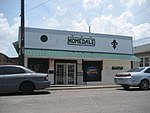8th National Eucharistic Congress (United States)
1938 in Louisiana20th-century CatholicismCatholicism in the United StatesEucharist in the Catholic ChurchEvents in New Orleans ... and 3 more
National Eucharistic congresses in the United StatesPages containing links to subscription-only contentUse mdy dates from July 2024

The Eighth National Eucharistic Congress was a Roman Catholic eucharistic congress held from October 17–20, 1938 (1938-10-17 – 1938-10-20) in the U.S. city of New Orleans, Louisiana, meant to foster devotion to the sacrament of the Eucharist. The congress was held in City Park Stadium. Archbishop of Chicago George Mundelein, a cardinal, served as a special papal legate for the congress.
Excerpt from the Wikipedia article 8th National Eucharistic Congress (United States) (License: CC BY-SA 3.0, Authors, Images).8th National Eucharistic Congress (United States)
Franklin D. Roosevelt Mall, New Orleans Faubourg St. John
Geographical coordinates (GPS) Address Nearby Places Show on map
Geographical coordinates (GPS)
| Latitude | Longitude |
|---|---|
| N 29.989444444444 ° | E -90.099444444444 ° |
Address
Reggie Bush Field
Franklin D. Roosevelt Mall
70119 New Orleans, Faubourg St. John
Louisiana, United States
Open on Google Maps










